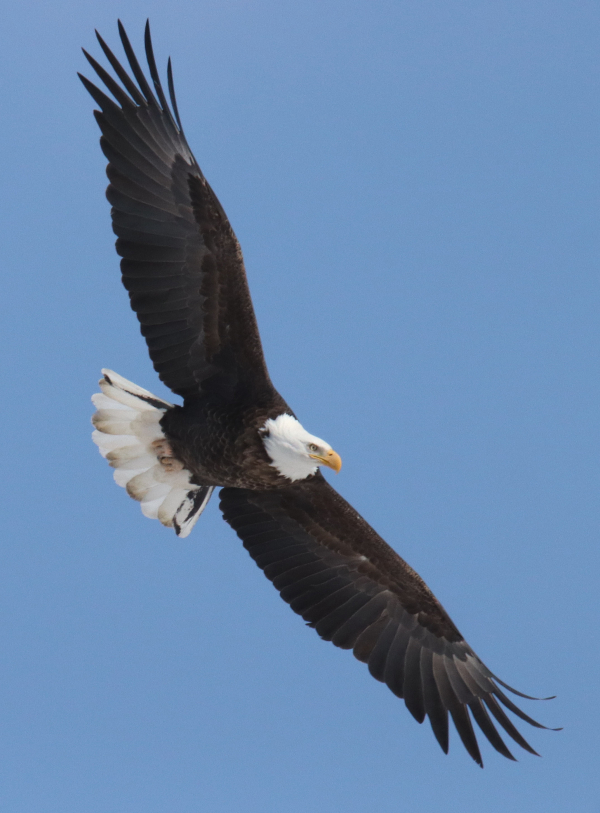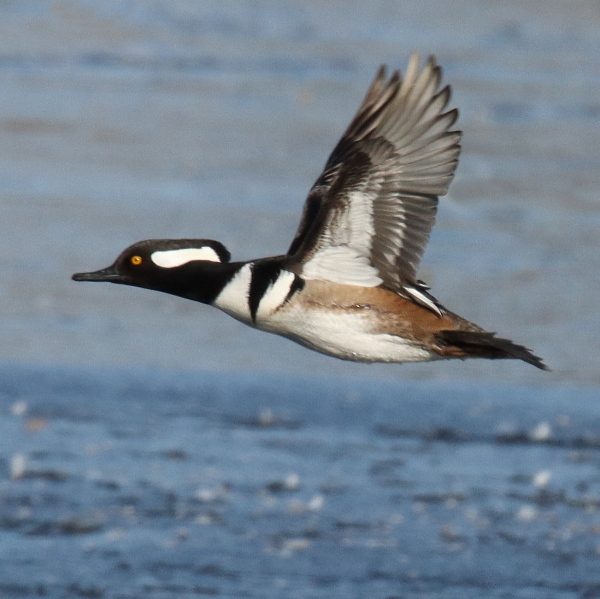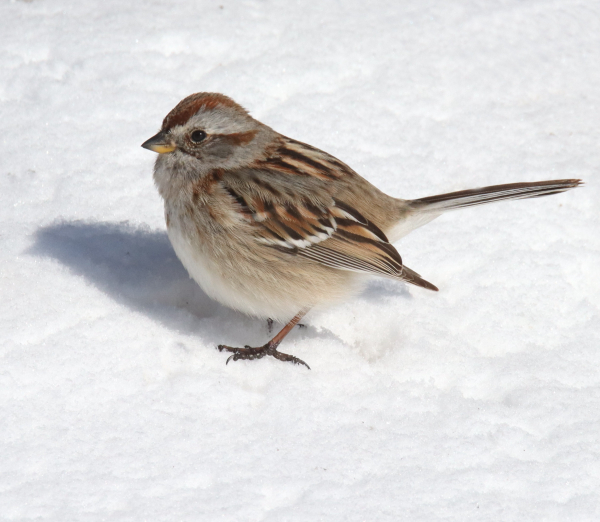
Bald Eagles continued to WoW our editor, as his photos of adults and young eagles suggest.

Slicing vertically against an especially strong wind, this adult Bald Eagle shows an example of the impressive eagle flights observed during recent weeks.

These 2 young Bald Eagles chased one another as if this was a social interaction, providing some spirited action photos in the process.

A close-up of a first-year Bald Eagle flying overhead shows a lot of feather details as well as the coloration of its hooked beak, eye, and feet.

A rare chance to photograph a Hooded Merganser in flight was a highlight of last week’s birding trip to Sand Lake Refuge.

A snow portrait of an American Tree Sparrow was a standout last week, although Lapland Longspurs and other songbirds vacated the area before the storm subsided last Wednesday.
|
A local concentration of Bald Eagles continue to attract my attention daily, thankfully. After counting 166 eagles on March 23rd, 3 days of strong northwest wind and freezing temperatures created something of a return to winter. My count numbers dropped quickly, probably because eagles and other birds were trying to avoid the intense wind and blowing snow; I could only find 57 the following Monday, but that’s a lot of eagles regardless of the weather. When the wind finally calmed Wednesday, my count was still only 62 Bald Eagles, but the total almost doubled to 121 Thursday – what a thrill to have so many eagles so close at hand!
The eagles are finding frozen food on the ice that covers Carlson Lake, just 7 miles north of my office, and as with anything related to birds, timing is everything. That point was emphasized by my 2 eagle surveys in the area of Carlson Lake last week on Good Friday. During my 10:30am survey, 72 Bald Eagles were evident; but at 4:00pm I counted 96, which is not a surprise considering the fluid movements of eagles into and out of the area, usually just 1 or 2 at a time. Other days, my impression was that fewer eagles were in the area later in the afternoon. There also appeared to be something of a flight of Red-tailed Hawks through the area, with 4 individuals sighted including 1 Krider’s Red-tail.
Saturday afternoon’s count was 78 Bald Eagles, and I observed a Red-tailed Hawk and an American Kestrel, with the mini-falcon hunting less than a quarter-mile from my office. Easter Sunday provided another eagle count that topped the century mark at 103, sighted along with a pretty tan female Northern Harrier and a silver male. Monday, sightings of a Red-tailed Hawk and 10 Tundra Swans on the way to the eagle lake preceded my count of 86 Bald Eagles. I knew extreme wind on Tuesday (yesterday) would dampen numbers of Bald Eagles, and that was again true, with numbers sighted similar to totals during the previous week’s storm – 56. It was unusual to see several adult Bald Eagles standing in a loose row on the ground in a harvested corn field south of the lake, rather than perching in a tree or standing on the snow-covered ice, likely to get out of the brunt of the wind’s force.
All in all, the eagles have provided a very special and enjoyable opportunity to observe many of these impressive birds in a central location close to home. In addition to counting the eagles, it was a particular thrill to try to photograph eagles that I crossed paths within range of my zoom camera lens. I provide more information about that in this issue’s Bird Photography feature along with more photographs.
Of course, each day concentrations of 5 species of geese are almost constantly within view – White-fronted, Cackling, Snow, Ross’s, and Canada Geese. Flocks are very mobile, and many are likely just passing by, but some have centered a half-mile south, 2 miles south, and 6 miles south of my office, along with flocks at 1½ miles north and 4 miles north. The northern-most geese are primarily made up of an especially large concentration of Snow and Ross’s Geese, with some smaller flocks of White-fronted Geese.
Not many knew ducks have been apparent as most wetlands and larger lakes remain frozen, but that will change quickly as temperatures will warm into the 60s and 50s for much of the foreseeable days ahead. Even so, a few Common Mergansers can be seen on the edges of the ice along with more Mallards and Gadwalls, flocks of Canvasbacks and larger flocks of Redheads and an occasional Hooded Merganser or Common Goldeneye. I will bet that more ducks and geese will populate the area by next week when I will update you.
Sand Lake Refuge
During each of the last 2 Wednesday’s, I drove an hour southeast to Sand Lake National Wildlife Refuge, and was surprised to see very similar totals of birds along the way and at the refuge. I’ll list the number of each species together, divided by a dash (–) here: Tundra Swans 16–14, Bald Eagles 8–10, Red-tailed Hawks 3–4, Rough-legged Hawks 1–0, Northern Harriers 2–1, Merlin 0–1, Sharp-tailed Grouse 8–0, Buffleheads 0–2, along with the above variety of ducks and geese, many Ring-necked Pheasants and a few American Robins in South Dakota, and a few Western Meadowlarks in North Dakota.
Window Views
The first day of April was marked by my first look at a robin outside my bay windows, and after 10 days, another Pine Siskin visited my feeding station Monday. The juncos have been camping out at and around my yard, centered at the platform feeder and the ground below my feeding station. Also on April Fool’s Day, 2 American Robins landed outside my windows during an afternoon work session, both males that quickly irrupted into a skirmish that would take wing and return to land. After sunset, a number of robins serenaded the area for the first time this year with Snow Geese calling in the background – a beautiful chorus.
Tuesday the total of Pine Siskins visiting my feeders doubled to 2, but I haven’t seen a nuthatch for some days, and no woodpeckers have stopped by for more than 2 weeks. The female Purple Finch continues to feed here periodically with a small flock of House Finches. So the juncos are holding down the fort, and as I was filling my feeders this morning (Tuesday) a few flocks of Snow Geese flew low overhead, calling, just above the tree tops. They almost became stationary above me as they faced into the intense wind, and I reveled in this lush bit of nature propelled by blustery spring weather. Hope you have some home-based thrills this week, and hope you have a chance to check on the progress of migration surrounding your home base too.
Article and photos by Paul Konrad
Share your bird sightings and photographs at editorstbw2@gmail.com